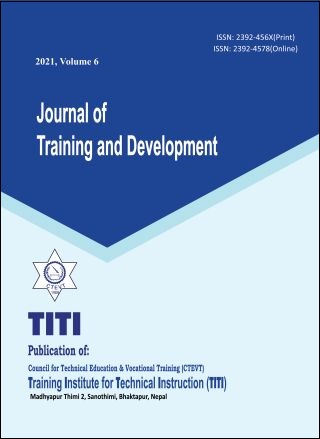Technical and Vocational Education and Training Fund in Nepal: Present Practice and Way Forward
DOI:
https://doi.org/10.3126/jtd.v6i01.41778Keywords:
Coordinated TVET system, TVET Fund, TVET Governance, TVET in NepalAbstract
In the last few decades, Technical and Vocational Education and Training (TVET) expanded significantly in Nepal. However, the actors of TVET are uncoordinated and are implementing programmes with fragmented governance. The international experience shows TVET fund is one of the approaches to coordinate fragmented TVET stakeholders and enhance the quality of TVET. In absence of such an integrated TVET fund in Nepal, this paper urges for establishing TVET fund and sketches the possible approaches with reformed TVET structure. For this, first, we reviewed the literature particularly the perceived international practices of implementing TVET fund. Further, we arranged an interaction with TVET stakeholders and collected their views on the establishment of the TVET fund in Nepal. Based on findings of the research, the paper provides five possible models for establishing TVET fund mechanism in Nepal. All the models have their strengths and challenges, so it would be rational to adopt the idea of strengthening existing structure rather than making it stand alone. For this, a developing strong research and innovation, effective implementing body, and independent quality assurance and accreditation system is equally important for its effective implementation.
Downloads
Downloads
Published
How to Cite
Issue
Section
License
Copyright (c) 2021 Prakash C. Bhattarai, Durga Prasad Baral, Prakash Kumar Paudel

This work is licensed under a Creative Commons Attribution 4.0 International License.
Authors who publish with this journal agree to the following terms:
- Authors retain copyright and grant the journal right of first publication with the work simultaneously licensed under a Creative Commons Attribution License that allows others to share the work with an acknowledgement of the work's authorship and initial publication in this journal.
- Authors are able to enter into separate, additional contractual arrangements for the non-exclusive distribution of the journal's published version of the work (e.g., post it to an institutional repository or publish it in a book), with an acknowledgement of its initial publication in this journal.
- Authors are permitted and encouraged to post their work online (e.g., in institutional repositories or on their website) prior to and during the submission process, as it can lead to productive exchanges, as well as earlier and greater citation of published work (See The Effect of Open Access).




